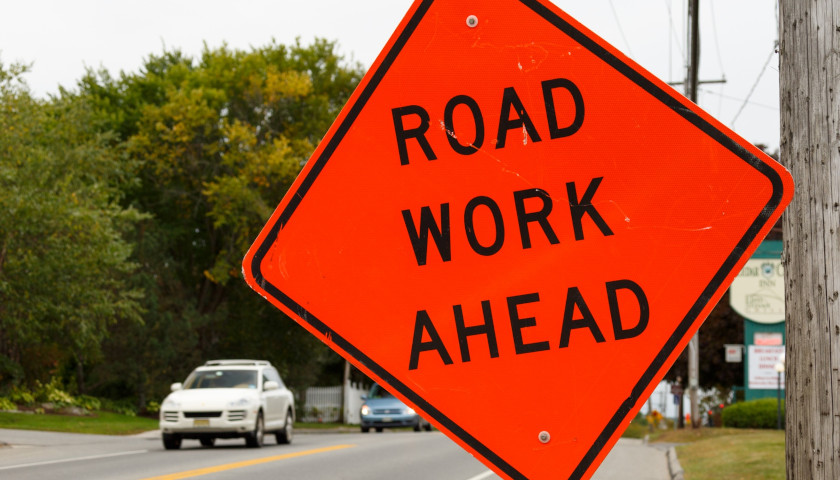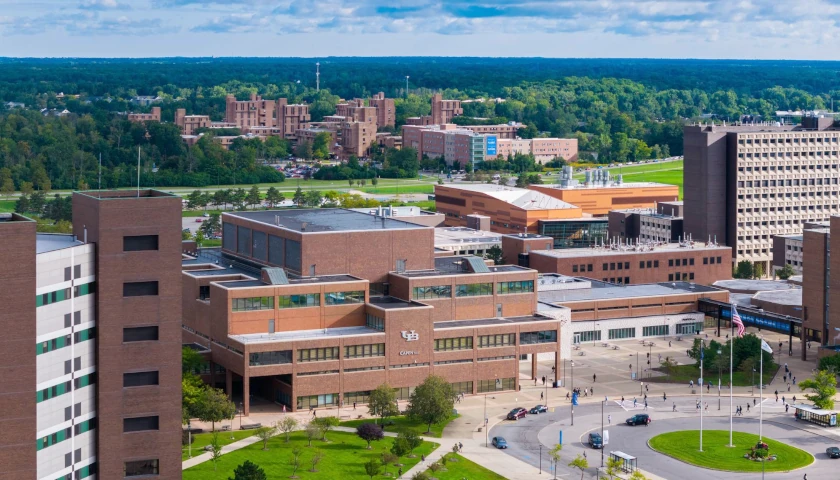by Theodore Roosevelt Malloch
Almost everyone, Republicans and Democrats alike, agrees that the United States needs a massive infusion of infrastructure development—especially now to boost the debilitating coronavirus effect on the economy.
Donald Trump is a builder by profession, and he should do a deal now with Congress to avoid a receding economy and rebuild the country in this time of novel coronavirus warfare.
To make this happen, the manner in which infrastructure projects are currently undertaken needs to be overhauled. In essence, we need new finance, regulatory, and political infrastructure to support more privately financed development in physical infrastructure. This can’t be business as usual or another expensive Democrat giveaway.
Federal infrastructure development too often gets bogged down in bad management and cost overruns. There is a misallocation to low-value activity and too many “bridges to nowhere” all due to politics.
At the state and local level, where a lot of infrastructure is owned and operated by the government, there is little to no political will to move toward a user-pays system and to properly maintain roads, bridges, waterworks, power systems, and airports.
Among the steps that can overhaul how infrastructure projects are conceived, financed, and managed is to end tax-exempt financing.
State and local governments, using tax-exempt finance, build about 90 percent of all infrastructure in the United States. This severely limits the pool of private capital and creates market distortions in how capital is allocated.
In addition, the United States needs regulatory reform and new sources of capital, as well as scalable tools to locate, fund, and deploy infrastructure capital where it is most needed.
Policymaking needs to overcome the hurdles to private involvement in infrastructure. A longer-term focus and a vision rooted in the private sector from the Trump Administration is essential. Time is of the essence. It should be infrastructure next—and on a bipartisan basis and as a jet engine to relaunch the crippled U.S. economy.
How?
As long as infrastructure is owned and operated by state and local governments, there will continue to be little to no political will to move toward a more efficient and rational user pays system. That needs to change.
Infrastructure Needs
A worthy 21st-century infrastructure policy for the United States should address these four interlocking issues:
- Creating more sources of capital;
- Creating more scalable tools;
- Providing regulatory relief for permitting and for federally subsidized loans; and
- Improving coordination on deal sourcing between private investors and the government (a Deal Syndicate Desk at the Commerce Department, to act as a mechanism for coordination of all infrastructure investments).
There are a number of related, supporting requirements, which also need to be addressed if a new infrastructure plan is to be truly effective and benefit all.
On Regulatory Reform: We need a conversation on regulatory relief, which must be part of any new policy or funding about infrastructure development and financing. Davis-Bacon labor rules, duplicative environmental impact statements for permitting, and overregulation must be culled in anticipation of the projects ahead.
On Creating New Sources of Capital/New Scalable Tools: The United States does not need a new, bureaucratic and politically based infrastructure bank. That is a particularly bad idea because it gives too much power to a single bureaucratic entity to allocate capital. Even in the private sector, banks are necessary conduits for allocating capital, but the market must be the final arbiter of how capital is deployed.
At the same time, we do need an innovative and agile mechanism to locate, fund and deploy capital where it is most needed and where it is best suited, a scalable system capable of performing under the expanding workload as urgent infrastructure development gets underway.
To start, the United States needs to eliminate tax-exempt bonds and replace them with “Build America Bonds”—which hereafter should be called “Trump Bonds”—that would subsidize the issuer rather than the investor. They would focus on ways to jumpstart the economy coming out of the economic pandemic.
This would open the market to a large number of global investors rather than limit the pool of capital to just U.S. taxpayers.
We also need new user-pays road and infrastructure-financing projects, made possible by private sourcing and the placement of such deals. Ideally, these deals would be coordinated in a new “syndicate desk” in the U.S. Department of Commerce that would operate like similar desks on Wall Street.
A syndicate desk is used to launch a new deal and gather enough data to execute it properly and successfully. In Wall Street firms, a member of the syndicate team performs research by talking directly to investors or by going through an investment bank and talking to appropriate parties. This provides a better understanding of the relevant market dynamics and variables. After gathering enough data, the syndicate team reports the findings to those wishing to launch a new deal and then collaborates with them in order to make a recommendation that is feasible and sellable. Such a syndicate desk at the Commerce Department would work in tandem with the capital markets and interface from the government side on all infrastructure deals.
The present approach to infrastructure limits the pool of private capital to projects where the financial benefits from bond financing accrue almost entirely to retail investors and banks that pay federal taxes and depend on public securities, primarily those with an investment-grade rating. This overly concentrated approach is susceptible to demand and supply imbalances, creating market distortions in how capital is being allocated.
A new infrastructure plan would work to overcome these distortions and create both viable projects and adequate private-sector funding from the widest source of funders.
The Politics of Infrastructure
A lot of the country’s infrastructure is owned and operated by local and state governments. The politics of governmental budgeting often impair the maintenance of infrastructure assets. It is time to overcome the lack of political will to change this and move toward a user-pays system. This will let the United States maintain the critical assets that drive our economy more reliably and consistently.
Time and Uncertainty Cost Money: The length of time and the added cost burdens (soft and hard) imposed by extremely lengthy environmental impact studies and design and permitting processes balloon project costs. This creates uncertainty and causes very long lead times before project revenues and benefits can be realized. This results in government capital, with low expected returns, being the only de facto source of financing—another capital allocation distortion.
Funding vs. Financing Shortfalls: There are many capital and financing sources interested in infrastructure investments. But they are not being matched efficiently with infrastructure development needs. The problem is a lack of funding to pay for infrastructure projects. This underscores the importance of more user fee models.
Maintenance, Operations and Revenue Discipline: Infrastructure requires not only large upfront investments, but also reliable ongoing investments in the operations and maintenance of assets. Deferring maintenance can result in repairs that can cost 10 times more than regularly scheduled maintenance would cost. The political nature of government budgeting makes it too easy to defer maintenance. It also makes it hard to increase fees/rates/charges on par with inflation, much less with real costs. In short, governments are not good at maintaining infrastructure or maintaining discipline or increasing required revenues
Overly Prescriptive Designs vs. Outcome/Performance-Based Metrics: Governments meddle too much and act in an overly prescriptive manner when building infrastructure. It doesn’t matter if the transit line seats are red or blue, just that the trains are on time and clean. Infrastructure needs to be evaluated and designed based upon the desired outcomes—what should be termed performance-based infrastructure.
Alternative Delivery and Risk Transfer: Modern, democratic government’s core competency is not building projects. Nevertheless, government’s lower financing costs from the subsidy provided by tax-exempt bonds create an advantage that puts government officials in the driver’s seat. This causes them to believe they should be the developer/builder/owner of infrastructure assets, again distorting ownership decisions.
Cost overruns and change orders by contractors too often drive up project costs. The tendency for governments to meddle and overengineer projects dramatically increases costs. Creating a level playing field by allowing Trump Bonds for any infrastructure project, regardless of ownership/operations or eliminating tax-exempt bond subsidies altogether, would eliminate this ownership distortion and permit more construction/ownership risk transfer to the private sector. The American infrastructure market would function more like other markets that do not have this ownership distortion caused by tax-exempt bonds.
National Infrastructure Banks as Early Stage Developer or Aggregator: There are many risks in creating a National Infrastructure Bank. If created, it should only serve to make more capital available and not to compete with capital markets. Otherwise, it would replicate the distorting effects of the failed Fannie Mae/Freddie Mac model in housing.
Even if a NIB would merely consolidate the various existing federal loan programs at the Department of Transportation, the EPA, or Commerce there is the risk this may create another slow and cumbersome bureaucracy and also that it would have a bias about which projects get funding.
At most, a NIB could serve a role by providing more “development” or seed capital for projects that have too long a lead time before revenue stability for private capital. But the NIB should look to resell such projects into the markets once up and running and recycle the funds. They should also provide access to capital for smaller issuers who the SEC would prefer did not access the broader private capital markets.
Private Infrastructure
Few infrastructure projects are truly national endeavors, such as the interstate highway system of sixty years ago. Most projects are of local and state interest and value. As the federal government oversees infrastructure projects across the country, however, it too often gets bogged down in bad management and cost overruns. There is a misallocation to low-value activity and too many “bridges to nowhere” due to politics. Decentralizing policy to the level closest to reality that includes financing, management, and ownership, is a better way ahead.
In addition, while government has often underwritten expensive, high-risk investments such as early forays in space exploration, the private sector is more likely to make sound investments in fundamental needs. And these are made without gigantic and unnecessary subsidies, strings attached, and overregulation. Privatization promises to improve economic efficiency, add more economic growth, and reduce financial burdens on the U.S. taxpayer.
Most of America’s infrastructure is actually provided by the private sector, not governments.
Indeed, private infrastructure spending is larger than all federal, state and local government infrastructure spending combined as measured in gross fixed investment in the National Income Accounts. Private infrastructure involvement in the U.S. is five times larger than total non-defense government investment. It should be allowed and encouraged to grow, not thwarted.
Spurring private infrastructure will equate to greater economic growth and investment. Past governmental efforts in infrastructure spending have shown numerous problems and failures regardless of which political party was in power. They have been typically laden with pork-barrel politics, earmarks, and bureaucratic mismanagement. Money is often misallocated.
Amtrak is a case in point. Investments are inefficient because supply and demand are not balanced by market prices. Water pricing is another good example, demonstrated by greatly underpriced irrigation in the western United States.
Mismanagement is the rule as incentives are not ensured or undercounted. The “Big Dig” in Boston exploded in cost to five times the original estimates. This is the norm, unfortunately, in government-based projects.
Washington’s mistakes are too often replicated around the country. High-speed rail, for example, has induced the states to spend money on uneconomical and unnecessary infrastructure. Policies on regulation, such as Davis-Bacon labor rules, raise the costs of infrastructure by demanding a one-size-fits-all mentality. These regulations and rules simply do not work as states have diverse needs.
The answer is therefore decidedly not more federal intervention but greater private involvement.
The United States is actually bucking global trends when it comes to private infrastructure. Worldwide the trend is toward infrastructure privatization. Since 1990, some $900 billion of state-owned assets have been sold in Organization for Economic Cooperation and Development (OECD) countries, of which 63 percent are infrastructure assets.
The OECD says this is due to a failure to deliver “efficient investment with misallocation across sectors, regions, and time due to political considerations.” In a recent report, the OECD concluded a “widespread recognition around the world of the need for greater recourse to private sector finance in infrastructure.”
The United States currently is lagging far behind Australia and Europe when it comes to private spending on infrastructure. Other countries have moved far ahead of the United States in the privatization of infrastructure, such as roads, tunnels, and bridges. According to Public Works Financing, only one of the top 38 firms doing transportation infrastructure around the world is American; and of the more than 700 projects underway globally, only 28 are in the United States. This is corroborated by numerous findings from the Government Accounting Office, the Congressional Budget Office, as well as from Ernst and Young and the Brookings Institution.
A Missed Opportunity
Infrastructure is a complex issue that crosses economics, engineering, policy, and finance. The American Society of Civil Engineers (ASCE) has elaborated a number of dramatic costs the country suffers by not addressing our U.S. infrastructure crisis, including:
- $1.3 trillion loss in GDP
- $3,100 per year drops in personal disposable income per U.S. household
- 3.5 million job losses
- $1.2 trillion in revenue costs to U.S. businesses
- $611 billion added costs to U.S. households.
The National League of Cities reported in 2019 on declining American infrastructure and detailed 10 challenges facing U.S. cities, of which, “fragile fiscal health” and “deteriorating transportation infrastructure,” were the first and second priorities.
In recent years, political polarization has meant infrastructure development and repair has suffered. The federal political stalemate has nearly strangled U.S. infrastructure investment. Whereas European nations spend five percent of GDP, and China nine percent of GDP on infrastructure, the United States only invests 2.4 percent of its GDP, and that number is on the decline.
Experience shows that when private businesses take risks and put their profits on the line, funding is more properly allocated to high-return projects that are completed on time and on budget, i.e., in the most efficient manner possible. Private infrastructure is also more efficient because it can tap the capital markets to build capacity and meet market demand without having to rely on slow, cumbersome and politicized government budgets.
Policymaking needs to overcome the hurdles to private involvement in infrastructure. We need to realize that private infrastructure is not a new idea. Almost all of the U.S. urban transit systems used to be private. Earlier turnpikes built thousands of miles of roads. Private markets financed the entire industrial revolution of previous centuries in both the United States and in England.
The Muni Market Today
The term “municipal bonds” or monism describes bonds issued by states, counties, cities, school districts, public utilities, ports, and other units of government that are not national in scope. This is what is called the muni market.
With more than 1 million bonds in the market and total par value of over $3.6 trillion, and more than 50,000 individual units of government-issued bonds, the total number of bonds sold each year varies from over $200 billion to just under $400 billion.
The defining characteristic of this muni market, of course, is that investors do not pay federal income tax on the interest they receive. This muni exemption has been part of the U.S. tax code since before the progressive income tax was instituted in 1913. Even with this expansive tax-exempt market supply, elasticity of state and local capital investment is falling short.
Every few years, the American Society of Civil Engineers (ASCE) issues a Report Card of America’s Infrastructure. It has highlighted a growing gap between actual and needed levels of state and local capital investment on infrastructure. Grading U.S. infrastructure a D+, the report enumerates $3.6 trillion of essential, urgent capital investment needs—which is, ironically, about the size of the entire current municipal market.
The U.S. Treasury forgoes revenue as a result of the muni exemption. This tax expenditure is estimated at $14 billion annually. The Congressional Research Service suggests the tax subsidy is actually closer to $28 billion a year..
As part of the American Recovery and Reinvestment Act of 2009, Congress authorized a stimulus of temporary new borrowing called Build America Bonds. The federal government in effect paid a subsidy to any state or local government that sold these bonds. This is in contrast to traditional munis, where the subsidy flows to investors who buy the bonds.
Noticeably, in recent years the muni bond market shrank for the fifth straight year, falling to $3.65 trillion, according to Federal Reserve data. The overall muni market has shrunk by over $150 billion from its peak in 2010. This reflects a reduced issuance, as municipal governments have become less prone to debt and less aggressive borrowers. Many are unwilling to raise taxes or reduce funding for existing services to finance new infrastructure. The muni market has also suffered from a significant shift in credit quality. AAA ratings are now uncommon as major bond insurers began to lose their own high ratings in the wake of the credit crisis.
Alternatives to Debt Financing for Infrastructure
There are two alternatives to traditional tax-exempt debt financing: pay-as-you-go and public-private partnerships.
The pay-as-you-go alternative is used to finance a capital investment with current resources rather than borrowed ones. Pay-as-you-go has many advantages because it is flexible and allows a government to procure a capital asset at the best available timing and pricing. It is also more transparent. The cost to procure is the purchase price of the asset. Debt financing comes with interest payments and transaction costs paid over many years. However, pay-as-you-go financing is difficult because it is not scalable. Large projects cost too much, and reserves are rarely in place.
Public-private partnerships are an agreement where partners from both sectors share risks and rewards of delivering and operating an asset over an extended period of time. Successful public-private partnerships are predicated on trust and a fair sharing of relevant risks. Failure can have significant financial, legal, and political consequences. Many experts suggest that for these reasons, PPPs are not a robust alternative to traditional municipal bonds, while experimentation continues.
President Trump’s proposed policies will have an immediate effect on the municipal bond market for investors in a number of decided ways. Trump Bonds would be seen as a way to create jobs and stimulate the economy. President Trump has said he wants to use them to create more infrastructure and repair old and outdated infrastructure. Again, since they would not be tax-exempt, these bonds are more appealing to international bondholders and institutional investors who are not eligible to claim an exemption. In this sense, they widen the market and bring in new, large participants. Private sector infrastructure could be greatly enhanced by more of these bonds.
Recent analysis by a number of research and ratings agencies further suggests that the Trump tax plan will affect the municipal market because it would eliminate or reduce tax exemption for municipal bondholders. This will reshape who buys municipal bonds. If the tax exemption on income earned from the investment were eliminated for the wealthy, there would be little motivation for such bondholders to buy more municipal debt.
Solutions and Opportunities
Historical approaches have proven insufficient to address our growing U.S. infrastructure gap. Public infrastructure (roads, bridges, transit, water, wastewater, energy, social) is fundamentally local and highly fragmented.
Federal funding and new programs should be leveraged to transform the infrastructure market and encourage more market-based solutions, rather than just federal handouts. Federal initiatives should be used to create more scalable financing markets, level the playing field for more private sector involvement, provide “at-risk” capital, depoliticize the selection of projects, and create more efficient vehicles for small and rural issuers to access capital. Regulatory and permitting burdens need to be reduced or streamlined.
Finally, essential infrastructure needs more dedicated funding sources from project-related revenues, local revenues, or user fees from the ultimate beneficiaries. A menu of solutions to address existing challenges, not one silver bullet, is necessary.
Almost everyone agrees that the United States needs a massive infusion of infrastructure development starting this year. That is even more critical as a way to move the country out of its short-term recession due to the COVID-19 pandemic. Over 70 percent of Americans of all political persuasions want government at all levels to do more about improving and building new infrastructure.
The fourth industrial revolution is underway and includes artificial intelligence (AI), driverless vehicles, supersonic aircraft and a raft of emerging technologies all of which demand new and better infrastructure such as the “internet of things,” robotics, 3D printing, nanotechnology, biotechnology, and quantum computing. The new digital revolution we are just beginning is characterized by a fusion of technologies that is blurring the lines between the physical, digital, and biological spheres. Our infrastructure must keep pace with new technologies if the United States is to remain competitive and a center of innovation for the rest of this and coming centuries.
Since infrastructure projects are notoriously plagued by long pre-construction periods, under-utilization of the P3 and alternative funding models, and an outright inability to gain public support and access to capital, the United States needs a new private-sector plan to accomplish its long-term needs in infrastructure.
As has been true historically, the United States is not simply lacking capital for infrastructure—capital is cheaper than ever with interest rates moving even lower—but policies are needed to attract this capital and deploy it efficiently for infrastructure based on market principles. We need to tap into the private global capital markets to access private capital to restore and build innovative infrastructure for the 21st century.
Underinvestment in infrastructure comes as a result of shortsightedness. As long as taxpayer investment in infrastructure is misaligned with politics, which has a short term and expedient focus, we will fail to meet our long-term needs as a country. We need to use the private sector and the measures enumerated to break new ground and to find private sources for infrastructure development.
A focus and a vision rooted primarily in the private sector from the Trump Administration are needed and most timely. It is time to push infrastructure as the fourth leg in the plan to recover from the coronavirus.
– – –
Theodore Roosevelt Malloch is a scholar, diplomat, and strategist who was active in the Trump campaign in 2016.




